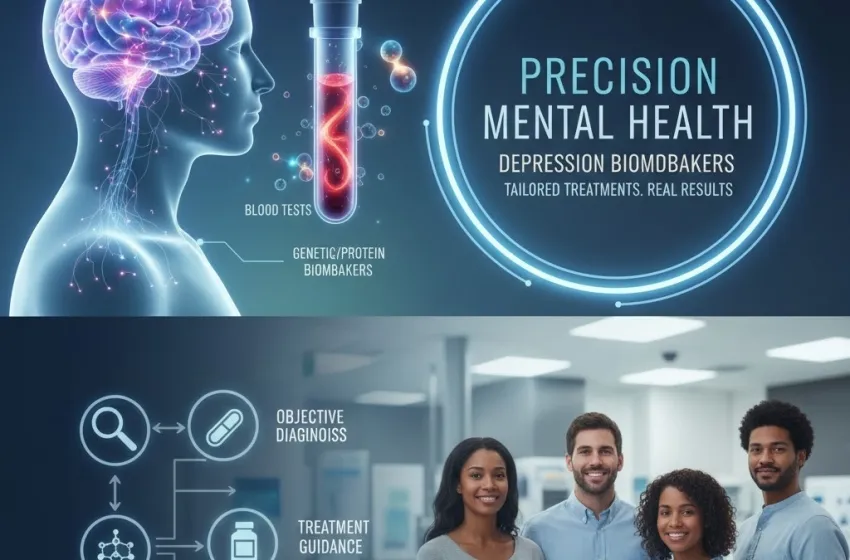Explore Precision Mental Health and the search for depression biomarkers to enable objective diagnosis
Major Depressive Disorder (MDD), or depression, is a leading cause of disability worldwide, yet its diagnosis and treatment selection remain largely empirical. The current gold standard relies on subjective patient reporting and clinical assessment of symptoms, a method that often leads to a lengthy, frustrating, and costly "trial-and-error" approach to medication and therapy. This inherent imprecision underscores the urgent need for a paradigm shift toward Precision mental health. This movement seeks to revolutionize psychiatric care by leveraging an individual’s unique biological makeup to enable an objective diagnosis, more accurate prognosis, and personalized psychiatric treatment guidance.
The cornerstone of this revolution is the identification and validation of robust depression biomarkers. These are measurable biological characteristics—such as genetic variations, protein levels in the blood, or specific patterns detected through brain scans—that indicate the presence, severity, or subtype of depression, and, crucially, predict how a patient will respond to a particular treatment.
The Search for Objective Diagnosis: Biological Markers
The ultimate goal of biomarker research is to move beyond symptom-based diagnosis to a biology-informed classification of depression. This requires the development of reliable biological markers that can be objectively measured in the lab or clinic.
Blood-Based Biomarkers: The Peripheral Signature
The bloodstream acts as a central hub, reflecting complex physiological and pathological processes occurring throughout the body, including the central nervous system. Researchers are actively investigating numerous molecules in blood, urine, and saliva as potential depression biomarkers. These peripheral indicators are particularly appealing due to their non-invasive nature and relative ease of measurement.
- Inflammatory Markers: A robust body of evidence links chronic low-grade inflammation to the onset and persistence of depression. Elevated levels of pro-inflammatory cytokines, such as Interleukin-6 (IL-6), Tumor Necrosis Factor-alpha (TNF-α), and C-Reactive Protein (CRP), have been consistently observed in depressed patients, especially those with atypical features or treatment resistance. These markers not only aid in diagnosis but also suggest that anti-inflammatory agents could be an effective treatment for a subgroup of patients.
- Neuroendocrine Markers: The hypothalamic-pituitary-adrenal (HPA) axis regulates the body’s stress response. Dysfunction in this system, often characterized by elevated cortisol levels, is a common feature of depression. Dynamic monitoring of cortisol in blood, saliva, or even hair (to reflect chronic levels) could serve as a valuable diagnostic and prognostic marker. Furthermore, Brain-Derived Neurotrophic Factor (BDNF), a protein crucial for neuronal growth and survival, is often reduced in depression, and its increase may indicate a positive response to antidepressant treatment.
- Genetic and Epigenetic Markers: Pharmacogenetics, a key component of precision mental health, focuses on how an individual's genetic variations influence drug response. For example, polymorphisms in genes coding for cytochrome P450 enzymes (like CYP2D6 and CYP2C19) can affect the metabolism of many antidepressants, influencing dosing and side effects. More broadly, epigenetic changes—such as DNA methylation—that regulate the expression of stress-response genes (e.g., SLC6A4, which codes for the serotonin transporter) are emerging as promising risk and treatment-response depression biomarkers.
- Metabolomics and Proteomics: Advances in 'omics' technologies allow for the comprehensive analysis of thousands of small-molecule metabolites (metabolomics) and proteins (proteomics) in a patient's sample. These studies are identifying specific metabolic signatures—like alterations in amino acid pathways (e.g., tryptophan metabolism) or unique protein clusters—that can accurately differentiate depressed patients from healthy controls and even distinguish between different clinical subtypes.
Neuroimaging: Peering into the Brain with Brain Scans
While blood-based markers offer systemic insights, structural and functional brain scans provide a direct window into the neurobiological underpinnings of depression. Neuroimaging techniques are vital for identifying specific brain circuit dysfunctions that characterize depressive subtypes, paving the way for truly individualized interventions.
- Functional Magnetic Resonance Imaging (fMRI): Resting-state fMRI measures spontaneous activity across brain regions, revealing patterns of 'functional connectivity.' Studies consistently show altered connectivity in neural networks associated with emotion regulation, self-referential thought (the Default Mode Network), and reward processing in depressed individuals. The identification of distinct neurophysiological subtypes using fMRI-derived functional connectivity maps holds great promise for predicting which patients will benefit from specific treatments, such as Cognitive Behavioral Therapy (CBT) or targeted neuromodulation.
- Structural MRI: Structural brain scans measure the volume and integrity of brain regions. Findings, though often subtle, include reduced gray matter volume in the hippocampus and prefrontal cortex in some individuals with chronic or recurrent depression. These structural biological markers may indicate disease severity and chronicity.
- Positron Emission Tomography (PET): PET scans use radioactive tracers to visualize specific molecular processes in the brain, such as neurotransmitter receptor binding or neuroinflammation. For example, tracers that bind to the translocator protein (TSPO) can quantify microglial activation, a key indicator of neuroinflammation, which is implicated in a subset of depression cases. PET offers a way to objectify the presence of specific molecular pathologies.
Guiding Treatment: From Trial-and-Error to Precision
Currently, the selection of psychiatric treatment guidance for depression is often a matter of educated guesswork. A patient may cycle through multiple antidepressant classes—SSRIs, SNRIs, tricyclics—before finding one that offers adequate relief, a process that can take months or even years. The core value proposition of precision mental health is to eliminate this delay by using depression biomarkers to match the patient's unique biology to the most effective treatment from the outset.
The application of biological markers for psychiatric treatment guidance breaks down into three main categories:
- Predictive Biomarkers: These markers forecast how an individual will respond to a specific intervention. For example, certain genetic variants (pharmacogenetics) might predict a poor response to a specific SSRI, prompting a clinician to choose an alternative drug or treatment modality. Similarly, specific patterns on brain scans (e.g., hyper-connectivity in certain limbic circuits) could predict a favorable response to targeted neuro-stimulation techniques like Transcranial Magnetic Stimulation (TMS).
- Diagnostic/Stratification Biomarkers: These markers help to subdivide the heterogeneous clinical diagnosis of depression into biologically distinct subtypes, or 'biotypes.' For instance, one biotype may be characterized by high inflammation (guiding the use of anti-inflammatory adjuncts), while another may exhibit prominent HPA axis dysfunction (suggesting treatments that modulate the stress response). This ability to achieve an objective diagnosis of subtype is critical for precision.
- Monitoring Biomarkers: These markers track the efficacy of treatment and help monitor the course of the illness. For example, measuring changes in BDNF levels or inflammatory markers in the blood could provide an early, objective diagnosis of whether a prescribed antidepressant is working, well before clinical symptoms fully reflect the improvement.
Challenges and Future Directions
The field of Precision mental health for depression, while incredibly promising, faces significant hurdles. Depression is a profoundly heterogeneous disorder, influenced by a complex interplay of genetic, environmental, and psychosocial factors. This complexity makes the identification of a single, highly sensitive, and specific depression biomarker for the entire population improbable.
The current consensus is that the future lies in multimodal integration. This involves combining different types of biological markers—genetic data, peripheral biological markers from blood, and structural/functional insights from brain scans—and integrating them with clinical and digital phenotype data (e.g., sleep patterns, activity level) using advanced analytical tools like Artificial Intelligence (AI) and Machine Learning (ML). These computational approaches are adept at identifying subtle, high-dimensional patterns that a human clinician could not discern, ultimately leading to highly accurate predictive algorithms that provide sophisticated psychiatric treatment guidance.
Furthermore, translating these exciting research findings into clinical practice requires standardization of biomarker measurement, regulatory approval for diagnostic and predictive tests, and extensive training for clinicians in this new era of biology-informed mental healthcare. Precision mental health promises to transform depression care from a reactive, symptom-driven process to a proactive, biology-informed one, offering hope for faster, more effective relief for millions of individuals.
The NIMH held a technical assistance webinar focused on developing predictive tools and depression biomarkers to inform treatment selection, and you can learn more about this initiative in the video, NIMH TA Webinar: Precision Mental Health: Develop Tools to Inform Treatment Selection in Depression.



































